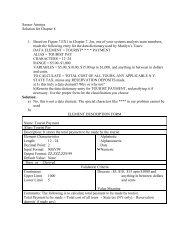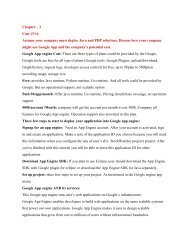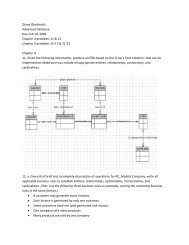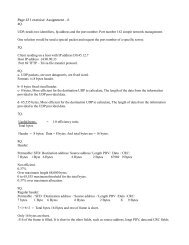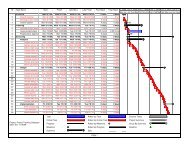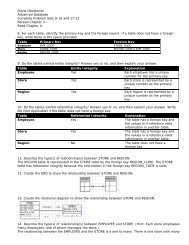IEEE 802.11 Media Access Control ppt - Csmaster
IEEE 802.11 Media Access Control ppt - Csmaster
IEEE 802.11 Media Access Control ppt - Csmaster
Create successful ePaper yourself
Turn your PDF publications into a flip-book with our unique Google optimized e-Paper software.
CWNA Guide to Wireless<br />
LANs, Second Edition<br />
Chapter Five<br />
<strong>IEEE</strong> <strong>802.11</strong> <strong>Media</strong> <strong>Access</strong> <strong>Control</strong> and<br />
Network Layer Standards
Objectives<br />
• List and define the three types of WLAN<br />
configurations<br />
• Tell the function of the MAC frame formats<br />
• Explain the MAC procedures for joining,<br />
transmitting, and remaining connected to a WLAN<br />
CWNA Guide to Wireless LANs, Second Edition 2
<strong>IEEE</strong> Wireless LAN Configurations:<br />
• Basic Service Set<br />
• Extended Service Set<br />
• Independent Service Set<br />
CWNA Guide to Wireless LANs, Second Edition 3
<strong>IEEE</strong> Wireless LAN Configurations:<br />
Basic Service Set<br />
• Basic Service Set (BSS): Group of wireless<br />
devices served by single AP<br />
– infrastructure mode<br />
• BSS must be assigned unique identifier<br />
– Service Set Identifier (SSID)<br />
• Serves as “network name” for BSS<br />
• Basic Service Area (BSA): Geographical area of<br />
a BSS<br />
– Max BSA for a WLAN depends on many factors<br />
(technology, obstructions, interference, battery<br />
power,…etc.)<br />
CWNA Guide to Wireless LANs, Second Edition 4
<strong>IEEE</strong> Wireless LAN Configurations:<br />
Basic Service Set (continued)<br />
Figure 5-1: Basic Service Set (BSS)<br />
CWNA Guide to Wireless LANs, Second Edition 5
<strong>IEEE</strong> Wireless LAN Configurations:<br />
Extended Service Set<br />
• Extended Service Set (ESS): Comprised of two or<br />
more BSS networks connected via a common<br />
distribution system<br />
• APs can be positioned so that cells overlap to<br />
facilitate roaming<br />
– Wireless devices choose AP based on signal<br />
strength<br />
– Handoff<br />
CWNA Guide to Wireless LANs, Second Edition 6
<strong>IEEE</strong> Wireless LAN Configurations:<br />
Extended Service Set (continued)<br />
Figure 5-2: Extended Service Set (ESS)<br />
CWNA Guide to Wireless LANs, Second Edition 7
<strong>IEEE</strong> Wireless LAN Configurations:<br />
Independent Basic Service Set<br />
• Independent Basic Service Set (IBSS): Wireless<br />
network that does not use an AP<br />
– Wireless devices communicate between themselves<br />
– Peer-to-peer or ad hoc mode<br />
• IBSS useful for quickly and easily setting up<br />
wireless network<br />
– When no connection to Internet or external network<br />
needed<br />
CWNA Guide to Wireless LANs, Second Edition 8
<strong>IEEE</strong> Wireless LAN Configurations:<br />
Independent Basic Service Set<br />
(continued)<br />
Figure 5-3: Independent Basic Service Set (IBSS)<br />
CWNA Guide to Wireless LANs, Second Edition 9
<strong>IEEE</strong> <strong>802.11</strong> <strong>Media</strong> <strong>Access</strong> <strong>Control</strong><br />
(MAC) Layer Standards<br />
• <strong>Media</strong> <strong>Access</strong> <strong>Control</strong> (MAC) layer performs<br />
several vital functions in a WLAN<br />
– Discovering WLAN signal<br />
– Joining WLAN<br />
– Transmitting on WLAN<br />
– Remaining connected to WLAN<br />
• Mechanics of how functions performed center<br />
around frames sent and received in WLANs<br />
CWNA Guide to Wireless LANs, Second Edition 10
MAC Frame Formats<br />
• Frames: Packet at MAC layer<br />
– Or Data Link layer in OSI model<br />
– <strong>IEEE</strong> <strong>802.11</strong> MAC frames different from 802.3<br />
Ethernet frames in format and function<br />
– Used by wireless NICs and APs for communications<br />
and managing/controlling wireless network<br />
CWNA Guide to Wireless LANs, Second Edition 11
MAC Frame Formats (continued)<br />
• Frame control field identifies:<br />
– Specific <strong>802.11</strong> protocol version<br />
– Frame type<br />
– Indicators that show WLAN configuration<br />
• All frames contain<br />
– MAC address of the source and destination device<br />
– Frame sequence number<br />
– Frame check sequence for error detection<br />
CWNA Guide to Wireless LANs, Second Edition 12
MAC Frame Formats (continued)<br />
<strong>IEEE</strong> <strong>802.11</strong> standard specifies three categories of<br />
MAC frames:<br />
• Management Frames<br />
• <strong>Control</strong> Frames<br />
• Data Frames<br />
CWNA Guide to Wireless LANs, Second Edition 13
MAC Frame Formats (continued)<br />
• Management Frames: Initialize communications<br />
between device and AP (infrastructure mode) or<br />
between devices (ad hoc mode)<br />
– Maintain connection<br />
Figure 5-4: Structure of a management frame<br />
CWNA Guide to Wireless LANs, Second Edition 14
MAC Frame Formats (continued)<br />
• Types of management frames:<br />
– Authentication frame<br />
– Association request frame<br />
– Association response frame<br />
– Beacon frame<br />
– Deauthentication frame<br />
– Disassociation frame<br />
– Probe request frame<br />
– Probe response frame<br />
– Reassociation request frame<br />
– Reassociation response frame<br />
CWNA Guide to Wireless LANs, Second Edition 15
MAC Frame Formats (continued)<br />
• <strong>Control</strong> frames: Provide assistance in delivering<br />
frames that contain data<br />
Figure 5-5: <strong>Control</strong> frame<br />
CWNA Guide to Wireless LANs, Second Edition 16
MAC Frame Formats (continued)<br />
• Data frame: Carries information to be transmitted to<br />
destination device<br />
Figure 5-6: Data frame<br />
CWNA Guide to Wireless LANs, Second Edition 17
Discovering the WLAN: Beaconing<br />
• At regular intervals, AP (infrastructure network) or<br />
wireless device (ad hoc network) sends beacon<br />
frame<br />
– Announce presence<br />
– Provide info for other devices to join network<br />
• Beacon frame format follows standard structure of<br />
a management frame<br />
– Destination address always set to all ones<br />
(broadcasting)<br />
CWNA Guide to Wireless LANs, Second Edition 18
Discovering the WLAN: Beaconing<br />
(continued)<br />
Figure 5-7: Beaconing<br />
CWNA Guide to Wireless LANs, Second Edition 19
Discovering the WLAN: Beaconing<br />
(continued)<br />
• Beacon frame body contains following fields:<br />
– Beacon interval<br />
– Timestamp<br />
– Service Set Identifier (SSID)<br />
– Supported rates<br />
– Parameter sets<br />
– Capability information<br />
• In ad hoc networks, each wireless device assumes<br />
responsibility for beaconing<br />
• In infrastructure networks beacon interval normally<br />
100 ms, but can be modified<br />
CWNA Guide to Wireless LANs, Second Edition 20
Discovering the WLAN: Scanning<br />
• Passive scanning: Wireless device simply listens<br />
for beacon frame<br />
– Typically, on each available channel for set period<br />
• Active scanning: Wireless device first sends out a<br />
management probe request frame on each<br />
available channel<br />
– Then waits for probe response frame from all<br />
available APs<br />
CWNA Guide to Wireless LANs, Second Edition 21
Discovering the WLAN: Scanning<br />
(continued)<br />
Figure 5-8: Active scanning<br />
CWNA Guide to Wireless LANs, Second Edition 22
Joining the WLAN: Authentication<br />
• Unlike standard wired LANS, authentication<br />
performed before user connected to network<br />
– Authentication of the wireless device, not the user<br />
• <strong>IEEE</strong> <strong>802.11</strong> authentication: Process in which AP<br />
accepts or rejects a wireless device<br />
• Open system authentication: Most basic, and<br />
default, authentication method<br />
• Shared key authentication: Optional<br />
authentication method<br />
– Utilizes challenge text<br />
CWNA Guide to Wireless LANs, Second Edition 23
Joining the WLAN: Authentication<br />
(continued)<br />
Figure 5-9: Open system authentication<br />
CWNA Guide to Wireless LANs, Second Edition 24
Joining the WLAN: Authentication<br />
(continued)<br />
Figure 5-10: Shared key authentication<br />
CWNA Guide to Wireless LANs, Second Edition 25
Joining the WLAN: Authentication<br />
(continued)<br />
• Open system and Shared key authentication<br />
techniques are weak<br />
– Open System: Only need SSID to connect<br />
– Shared Key: Key installed manually on devices<br />
• Can be discovered by examining the devices<br />
• Digital certificates: Digital documents that<br />
associate an individual with key value<br />
– Digitally “signed” by trusted third party<br />
– Cannot change any part of digital certificate without<br />
being detected<br />
CWNA Guide to Wireless LANs, Second Edition 26
Joining the WLAN: Association<br />
• Association: Accepting a wireless device into a<br />
wireless network<br />
– Final step to join WLAN<br />
• After authentication, AP responds with association<br />
response frame<br />
– Contains acceptance or rejection notice<br />
• If AP accepts wireless device, reserves memory<br />
space in AP and establishes association ID<br />
• Association response frame includes association<br />
ID and supported data rates<br />
CWNA Guide to Wireless LANs, Second Edition 27
Transmitting on the WLAN: Distributed<br />
Coordination Function (DCF)<br />
• MAC layer responsible for controlling access to<br />
wireless medium<br />
• Channel access methods: Rules for cooperation<br />
among wireless devices<br />
– Contention: Computers compete to use medium<br />
• If two devices send frames simultaneously, collision<br />
results and frames become unintelligible<br />
• Must take steps to avoid collisions<br />
CWNA Guide to Wireless LANs, Second Edition 28
Transmitting on the WLAN: Distributed<br />
Coordination Function (continued)<br />
• Carrier Sense Multiple <strong>Access</strong> with Collision<br />
Detection (CSMA/CD): Before networked device<br />
sends a frame, listens to see if another device<br />
currently transmitting<br />
– If traffic exists, wait; otherwise send<br />
– Devices continue listening while sending frame<br />
• If collision occurs, stops and broadcasts a “jam” signal<br />
• CSMA/CD cannot be used on wireless networks:<br />
– Difficult to detect collisions<br />
– Hidden node problem<br />
CWNA Guide to Wireless LANs, Second Edition 29
Transmitting on the WLAN: Distributed<br />
Coordination Function (continued)<br />
Figure 5-11: Carrier Sense Multiple <strong>Access</strong> with Collision<br />
Detection (CSMA/CD)<br />
CWNA Guide to Wireless LANs, Second Edition 30
Transmitting on the WLAN: Distributed<br />
Coordination Function (continued)<br />
Figure 5-11 (continued): Carrier Sense Multiple <strong>Access</strong> with<br />
Collision Detection (CSMA/CD)<br />
CWNA Guide to Wireless LANs, Second Edition 31
Transmitting on the WLAN: Distributed<br />
Coordination Function (continued)<br />
Figure 5-12: Hidden node problem<br />
CWNA Guide to Wireless LANs, Second Edition 32
Transmitting on the WLAN: Distributed<br />
Coordination Function (continued)<br />
• Distributed Coordination Function (DCF):<br />
Specifies modified version of CSMA/CD<br />
– Carrier Sense Multiple <strong>Access</strong> with Collision<br />
Avoidance (CSMA/CA)<br />
– Attempts to avoid collisions altogether<br />
– Time when most collisions occur is immediately after<br />
a station completes transmission<br />
– All stations must wait random amount of time after<br />
medium clear<br />
• Slot time<br />
CWNA Guide to Wireless LANs, Second Edition 33
Transmitting on the WLAN: Distributed<br />
Coordination Function (continued)<br />
• CSMA/CA also reduces collisions via explicit frame<br />
acknowledgment<br />
– Acknowledgment frame (ACK): Sent by receiving<br />
device to sending device to confirm data frame<br />
arrived intact<br />
– If ACK not returned, transmission error assumed<br />
• CSMA/CA does not eliminate collisions<br />
– Does not solve hidden node problem<br />
CWNA Guide to Wireless LANs, Second Edition 34
Transmitting on the WLAN: Distributed<br />
Coordination Function (continued)<br />
Figure 5-13: CSMA/CA and ACK<br />
CWNA Guide to Wireless LANs, Second Edition 35
Transmitting on the WLAN: Distributed<br />
Coordination Function (continued)<br />
• Request to Send/Clear to Send (RTS/CTS)<br />
protocol: Option used to solve hidden node<br />
problem<br />
– Significant overhead upon the WLAN with<br />
transmission of RTS and CTS frames<br />
• Especially with short data packets<br />
– RTS threshold: Only packets that are longer than<br />
RTS threshold are transmitted using RTS/CTS<br />
CWNA Guide to Wireless LANs, Second Edition 36
Transmitting on the WLAN: Distributed<br />
Coordination Function (continued)<br />
Figure 5-14: Request to Send/Clear to Send (RTS/CTS)<br />
CWNA Guide to Wireless LANs, Second Edition 37
Transmitting on the WLAN:<br />
Fragmentation<br />
• Fragmentation: Divide data to be transmitted from<br />
one large frame into several smaller ones<br />
– Reduces probability of collisions<br />
– Reduces amount of time medium is in use<br />
• If data frame length exceeds specific value, MAC<br />
layer fragments it<br />
– Receiving station reassembles fragments<br />
• Alternative to RTS/CTS<br />
– High overhead<br />
• ACKs and additional SIFS time gaps<br />
CWNA Guide to Wireless LANs, Second Edition 38
Transmitting on the WLAN: Point<br />
Coordination Function (PCF)<br />
• Polling: Channel access method in which each<br />
device asked in sequence if it wants to transmit<br />
– Effectively prevents collisions<br />
• Point Coordination Function (PCF): AP serves<br />
as polling device or “point coordinator”<br />
CWNA Guide to Wireless LANs, Second Edition 39
Summary<br />
• A Basic Service Set (BSS) is defined as a group of<br />
wireless devices that is served by a single access<br />
point (AP)<br />
• An Extended Service Set (ESS) is comprised of<br />
two or more BSS networks that are connected<br />
through a common distribution system<br />
• An Independent Basic Service Set (IBSS) is a<br />
wireless network that does not use an access point<br />
• Frames are used by both wireless NICs and<br />
access points for communication and for managing<br />
and controlling the wireless network<br />
CWNA Guide to Wireless LANs, Second Edition 40
Summary (continued)<br />
• The MAC layer provides four major functions in<br />
WLANs: discovering the WLAN signal, joining the<br />
WLAN, transmitting on the WLAN, and remaining<br />
connected to the WLAN<br />
• Discovery is a twofold process: the AP or other<br />
wireless devices must transmit an appropriate<br />
frame (beaconing), and the wireless device must<br />
be looking for those frames (scanning)<br />
• Once a wireless device has discovered the WLAN,<br />
it requests to join the network; This is a twofold<br />
process known as authentication and association<br />
CWNA Guide to Wireless LANs, Second Edition 41
Summary (continued)<br />
• The <strong>IEEE</strong> <strong>802.11</strong> standard specifies two<br />
procedures for transmitting on the WLAN,<br />
distributed coordination function (DCF) and an<br />
optional point coordination function (PCF)<br />
• The <strong>802.11</strong> standard provides for an optional<br />
polling function known as Point Coordination<br />
Function (PCF)<br />
CWNA Guide to Wireless LANs, Second Edition 42



